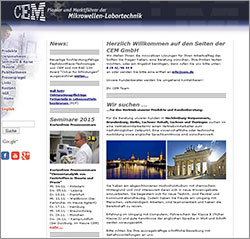Tag: Mars 6
| Für die chromatographische Analytik (GC/HPLC) und die gravimetrische Messung von Analyten bzw. Summenparametern ist häufig eine Lösemittelextraktion vorgeschaltet. Traditionell dauert die Soxhlet-Extraktion viele Stunden und benötigt eine große Lösemittelmenge. Im Rahmen dieses Online-Seminars erläutern Ihnen die Referenten Frank Scholten und Ulf Sengutta die modernen Lösemittel-Extraktionen von wenigen Milligramm Einwaage bis hin zu mehreren Gramm Einwaage u. a. mit folgenden Themen:
In praktischen Übungen werden live Proben bearbeitet. Und zudem können per Chat individuelle Fragen gestellt werden. Es besteht die Möglichkeit der Bearbeitung von Kundenproben nach dem Online-Seminar.
|
- März 2021
Für die Lebensmittel- und Bedarfsgegenstände-Analytik (§ 64 LFGB) und die Umweltanalytik sind schnelle, leistungsfähige und innovative Aufschlussverfahren von entscheidender Bedeutung. Das Aufschlussverfahren muss auf die nachfolgende Analytik der Hydrid-/Kaltdampf-/Flammen- oder Graphitofen-AAS, ICP-OES bzw. ICP-MS abgestimmt sein.
Im Rahmen dieses Web-Seminars erläutern Ihnen die Referenten Frank Scholten und Ulf Sengutta die modernen Mikrowellen-Aufschlussmethoden von wenigen Milligramm Einwaage bis hin zu mehreren Gramm bzw. Millilitter. Einwaage.
Lösemittel-Extraktionen im MARS und EDGE
Soils and river sediments were frozen and freezedried at ETH Zürich. Soils were sieved, and the fraction <2 mm was used for further analysis. Analytical techniques for brGDGT analyses follow Hopmans et al. (2016) and Freymond et al. (2017) and are summarized here with a detailed description in the supporting information. Briey, between 2 and 3 g of the soil samples and around 20 g of the river sediments were
extracted with solvents in a microwave or an automated extraction system. After purification via column chromatography and preltration, the GDGT distributions were analyzed by high performance liquid chromatography mass spectrometry (HPLC MS) at ETH Zürich.
Extraktion mit dem MARS und EDGE:
Lipids were extracted from dried soil samples using a microwave (CEM MARS5) or an Energized Dispersive Guided Extraction (CEM EDGE) system. No difference in performance was observed for the different extraction systems. Samples were processed in batches of roughly 15 to 20 g of material. For microwave extraction the samples were transferred to the extraction vessels and covered by a dichloromethane (DCM):methanol (MeOH) 9:1 (v/v, 25 ml) solvent mixture. Extraction temperature was programmed to ramp to 100 ◦C in 35 min and is subsequently held for 20 min. For EDGE extraction 25 ml DCM:MeOH 9:1105 (v/v) was used for extraction at 110 ◦C for 2 min and subsequent rinsing with 15 ml followed by a second extraction with 5 ml of solvent at100 ◦C and rinsing with35ml. The process was repeated on additional samplebatches to yield sufficient quantities of the target lipid compounds for 14C analysis. Pooled extracts were then dried under nitrogen flow.
Mittwoch, 24.2.2021 um 14.00 Uhr
Soil is one of the most common matrices in which semi-volatile organic compounds (SVOCs) are present. The extraction of these compounds from soil can be a lengthy and tedious process. Pressurized Fluid Extraction on the EDGE and Microwave Assisted Solvent Extraction (MASE) on the MARS 6 are proven techniques that are fast, simple, and efficient. EDGE is ideal for difficult samples while MARS 6 is ideal for high throughput labs dealing with hundreds of samples per day. Adhering to US EPA 3545A the EDGE offers a rapid automated process that yields a filtered sample. Adhering to US EPA 3546, the MARS 6 also offers an efficient extraction of up to 24 samples simultaneously. These two techniques offers solutions for rapid, simple and efficient extraction of SVOCs from soil. Join CEM’s Benedict Liu and Alicia Douglas Stell, PhD as they compare two methods for extraction of SVOCs from soil and discuss how each system can benefit your lab.
Registrieren Sie sich und nehmen Sie an der Live-Fragerunde teil
Mikrowellensynthese im MARS:
Rapid, microwave-assisted synthesis of Gd2O3 and Eu:Gd2O3 nanocrystals: characterization, magnetic, optical and biological studies
Low level quantification of trace metals in rice using ICP-MS
Lesen Sie: Mikrowellen-Aufschluss mit dem Mars 6

















